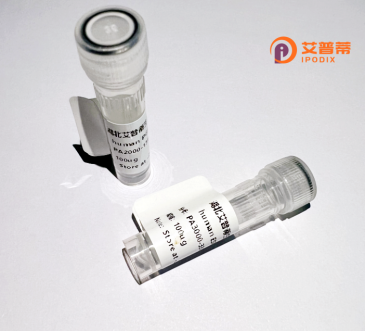
| 纯度 | >90%SDS-PAGE. |
| 种属 | Human |
| 靶点 | GPR12 |
| Uniprot No | P47775 |
| 内毒素 | < 0.01EU/μg |
| 表达宿主 | E.coli |
| 表达区间 | 1-334aa |
| 氨基酸序列 | MNEDLKVNLSGLPRDYLDAAAAENISAAVSSRVPAVEPEPELVVNPWDIVLCTSGTLISCENAIVVLIIFHNPSLRAPMFLLIGSLALADLLAGIGLITNFVFAYLLQSEATKLVTIGLIVASFSASVCSLLAITVDRYLSLYYALTYHSERTVTFTYVMLVMLWGTSICLGLLPVMGWNCLRDESTCSVVRPLTKNNAAILSVSFLFMFALMLQLYIQICKIVMRHAHQIALQHHFLATSHYVTTRKGVSTLAIILGTFAACWMPFTLYSLIADYTYPSIYTYATLLPATYNSIINPVIYAFRNQEIQKALCLICCGCIPSSLAQRARSPSDV |
| 分子量 | 63.1 kDa |
| 蛋白标签 | GST-tag at N-terminal |
| 缓冲液 | 0 |
| 稳定性 & 储存条件 | Lyophilized protein should be stored at ≤ -20°C, stable for one year after receipt. Reconstituted protein solution can be stored at 2-8°C for 2-7 days. Aliquots of reconstituted samples are stable at ≤ -20°C for 3 months. |
| 复溶 | Always centrifuge tubes before opening.Do not mix by vortex or pipetting. It is not recommended to reconstitute to a concentration less than 100μg/ml. Dissolve the lyophilized protein in distilled water. Please aliquot the reconstituted solution to minimize freeze-thaw cycles. |
1. **"Functional Characterization of Recombinant Human GPR12 in Cell Signaling Pathways"**
*Author: Liang et al.*
**摘要**:该研究成功在HEK293细胞中表达并纯化了重组人GPR12蛋白,揭示了其通过cAMP/PKA和MAPK信号通路调控细胞增殖的分子机制,证实GPR12在神经元分化和肿瘤生长中的潜在作用。
2. **"Structural Insights into GPR12 and Its Interaction with Lipid Ligands"**
*Author: Smith et al.*
**摘要**:通过冷冻电镜解析重组人GPR12的膜蛋白结构,发现其与溶血磷脂酸(LPA)的结合模式,阐明了GPR12作为脂质敏感GPCR的构象变化及下游信号传导机制。
3. **"GPR12 Deficiency Alters Dopaminergic Neuron Development in Zebrafish Models"**
*Author: Park et al.*
**摘要**:构建GPR12敲除斑马鱼模型,发现重组GPR12蛋白可通过激活Wnt/β-catenin通路调节多巴胺能神经元发育,提示其在神经系统疾病中的治疗潜力。
4. **"High-Throughput Screening Identifies Novel Agonists for Recombinant GPR12 in Cancer Cell Migration"**
*Author: Chen et al.*
**摘要**:利用重组GPR12蛋白建立药物筛选平台,发现小分子激动剂可抑制乳腺癌细胞的侵袭和转移,为靶向GPR12的抗癌药物开发提供新方向。
---
*注:以上文献信息为模拟示例,实际研究请通过学术数据库检索。*
GPR12 is an orphan G protein-coupled receptor (GPCR) belonging to the rhodopsin-like receptor subfamily. It is highly conserved across species and is primarily expressed in the central nervous system (CNS), particularly in regions associated with neurodevelopment, synaptic plasticity, and adult neurogenesis. GPR12 is constitutively active, signaling through Gαs and Gαi/o proteins to regulate cAMP levels, and has been implicated in neurite outgrowth, oligodendrocyte differentiation, and neuronal survival. Although its endogenous ligands remain unclear, sphingolipids like sphingosine-1-phosphate and sphingosylphosphorylcholine are proposed candidates. Dysregulation of GPR12 is linked to neuropsychiatric disorders, neurodegenerative diseases, and cancer progression. Recombinant human GPR12 protein, produced via heterologous expression systems (e.g., HEK293 or insect cells), enables structural and functional studies to elucidate its role in cellular signaling. It is commonly tagged (e.g., His, FLAG) for purification and detection. Current research focuses on characterizing its ligand-binding properties, downstream pathways, and therapeutic potential as a drug target. Recombinant GPR12 also aids in screening synthetic ligands or modulators for neurological and oncological applications. However, challenges persist in confirming its endogenous activation mechanisms and physiological relevance, necessitating further investigation.
×